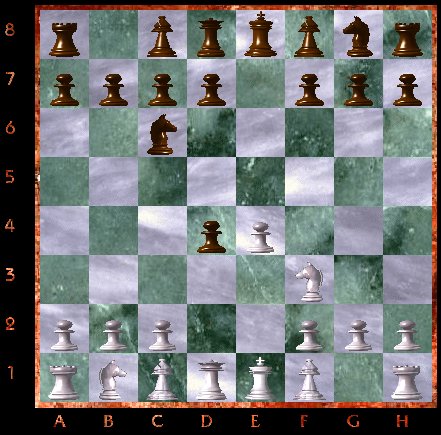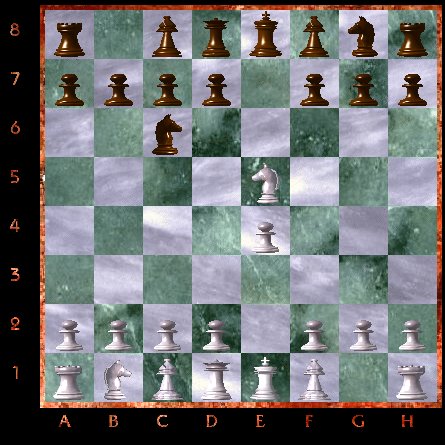Secret Agent Chess
by Ralph Betza
Secret Agent Chess is a game of partial information and minimum moderation, in which one piece from each army is a secret agent.
Historical Note
In the 1970s, there was no internet, and so the few chess variant players had to conquer distance by sending physical letters, on paper with postage stamps. In this context, playing Kriegspiel was prohibitively cumbersome and expensive because of the large number of interactions between the players and the moderator.For this reason, I developed the idea of minimum moderation. The primary, and perhaps the first, minimum moderation game, was High-Low Chess.
Minimum Moderation
In a game of partial information with minimum moderation, each player makes a secret choice before the game and sends it to the moderator. The moderator's only job is to retain this information and reveal it at the end of the game in order to prevent cheating.Playing face-to-face, no moderator is needed. You simply mark your choice on a slip of paper and put it face down beside the board.
Playing a series of games face-to-face, a good idea is to make a pack of choice cards, shuffle them, and have each player make a random choice.
Secret Agent Chess
Before the game, each player chooses one opposing minor piece to be a secret agent. For example, White might choose Black's Kingside Fibnif as his secret agent and Black might choose White's Queen's Bishop.When your opponent moves your secret agent, as long as it is not the first move of the game for that piece, you may intervene: you declare your secret agent, replace it with an identical piece of your color, and make a move with it (this is your turn; your opponent has lost a turn but the move you gain must be made with the formerly-secret agent piece). If this is not clear, see the examples later in the article.
The secret agent move may be any move or capture except that it may not capture the enemy King.
First Example

After the moves 1. e4 e5 2. Nf3 Nc6 3. d4 ed4, White tries to play 4. Nxd4. In our example, White's KN is Black's secret agent.
Black has the right to declare his secret agency, but should he?
In doing so, first the Nf3 would be replaced by a Black Knight, and then the Black Nf3 would make a move. Nf3xKe1 is forbidden, and so there is no better move than Nf3-e5, after which White's 5th move is played.
This looks strong, but in fact, it is nearly the minimum of what a secret agent could achieve, and remember, White still has a secret agent in Black's ranks and White now has the advantage of knowing that the rest of his pieces are loyal. This would be a bad bargain.
Even so, if 4. Nf3xd4 would normally be answered by Nc6xd4, Black should take this bad bargain. His failure to capture on d4 could be taken as a strong hint that the Nd4 is a secret agent.
In fact, 4...Nc6xd4 would be a bad move in ordinary Chess. Worse than that, 4...Nc6xd4 would be a very bad move in Secret Agent Chess, because if the Nc6 is White's secret agent, of course it will reject the move, change colors, and capture the Qd8.
Thus we see that Black should allow 4. Nf3xd4; but now if 4...Ng8-f6, White might try 5. Nd4xc6, and Black would be stuck. Allowing the move kills Black's secret agent, but still leaves White in doubt about the loyalty of his other pieces; rejecting the move, there is nothing better than Nd4-e6. Therefore, 1. e4 e5 2. Nf3 Nc6 3. d4 ed4 4. Nd4 Nf6? is a bad move; 4...Qh4 is worth a try because after the normal reply 5. Nd4-b5 there is no real threat of Nxc7.

Second Example

1. d4 e6 2. Bf4 Bb4+ 3. Bd2
These are not meant to be good moves; they illustrate a point in the rules.
If White's QB is the agent, 3.Bf4-d2 can be rejected: Bf4 is replaced by a Black Bishop which must move, and then White makes a move.
This is not checkmate. Interposing with a traitor is not fatal. Because Black must move the Bf4, the Bb4 has no chance to take the King.
After 1. d4 e6 2. f3 d5 3. Bf4 Bb4+ 4. (Bb4-d2), Bf4-g3+ is double check, and checkmate.

Third Example

1. e4 e5 2. Nf3 Nc6 3. Nxe5
Black must now suspect that Nc6 is the secret agent. One way to find out for sure is to play 3... (Nc6xe5) 4. Nc6xd8, but that is not a good result.
Perhaps Nc6 is not the agent, and White is bluffing! After 3...Nc6xe5, the N is known to be loyal, and Black is winning. Would you take the chance?
The prudent course might be 3...Qe7, regaining the Pawn.
If in response, White plays 4. Ne5xc6, then we know that 3.Ne5 was a bluff. Therefore, 4. d2-d4 d7-d6 5. Nf3 Qe4+, and if 6. Qe2 Qe2+ 7. Be2, should Black play 7...Nc6xd4!?
7...Nxd4 is not a bad idea if Nc6 is the secret agent, but if 3.Nxe5 was a bluff, 7...Nxd4 is a blunder!

Different Armies
The Colorbound Clobberers do not have 4 minor pieces, and therefore cannot play Secret Agent Chess.Other Ideas
Minimum moderation could be used in many other variants. Here are a few:Multiple Secrets
A game of minimum moderation could have multiple secrets.One could have a game where each side has a Secret Agent Pawn[1] in addition to the Secret Agent minor piece, and each side has a secret goal (for example, occupying f8 counts as a win for White), and a secret target (for example, checkmating the Pg2 wins for Black), and a secret intention (as in High-Low Chess).
With so many secrets, it could be difficult to figure out why your opponent made such a strange move.
[1] Note: should promoting a Secret Agent Pawn create a Secret Agent Queen? I would say yes, but worry that it could make a travesty of the endgame K+P versus K.
Identity Crisis
Each player chooses an army from a list of standard pieces, but it's a secret! After 1. g1-f3, Black knows that b1 and f3 are either Knights or Fibnifs or fbNW or Barc plus something.Fischer Random Identity Crisis would be possible.
Maximum Moderation
I leave it to the reader to imagine what a game of maximum moderation might be, and to ponder whether such a game would be desirable.
Summary
Compared to Kriegspiel, Secret Agent Chess has much less unknown information but is much more convenient to play.As in all games of partial information, the unknown affects play on the board. This makes the game very interesting, at least until both secret agents have been revealed; after that, the game reverts to normal Chess, which is also interesting of course.
Because of this, playing Secret Agent Chess with different armies is an especially good idea; then, if the game is still even enough to be worth continuing after the agents have been revealed, you still have something new and special.
Credits
The board images were made with Zillions of Games by Tony Quintanilla using a board graphic by Fergus Duniho.